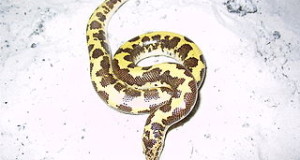 A recent article in the journal IRCF Reptiles and Amphibians (V17, 1) provides evidence that the African Rock Python (Northern African Python, Python sebae), may have established a breeding population in southern Florida. The huge constrictors are adapted to take small antelopes and other large animals, and have been killed and consumed people in their native habitat.
A recent article in the journal IRCF Reptiles and Amphibians (V17, 1) provides evidence that the African Rock Python (Northern African Python, Python sebae), may have established a breeding population in southern Florida. The huge constrictors are adapted to take small antelopes and other large animals, and have been killed and consumed people in their native habitat.
Florida’s Introduced Constrictors
At least 45 species of non-native reptiles and amphibians have established breeding populations in Florida; many others have been observed but are not known to be reproducing. Among these are 2 of the world’s largest snakes, the Burmese Python and the Boa Constrictor. Other large constrictors, including the Green Anaconda, Yellow Anaconda and White-Lipped Python, have been found at large in Florida.
Anacondas and others Established?
Given the extent of Florida’s wetlands and other densely-vegetated habitats, it is not unlikely that reproduction of other species has occurred unseen. Anacondas, being aquatic, are especially difficult to find. Years ago, I was told by a reliable source that an entire litter of Green Anacondas escaped from a roadside zoo near Florida City in the early 1970’s…nothing would surprise me at this point!
Northern African Python Study
The article mentioned above looked at Northern African Python sightings and captures in south Florida from 2002-2009. In that period, 7 individuals were found in a small (less than 10 square miles) area in Dade County. Among the captured snakes was an 15.5 foot-long adult female with eggs forming in the oviduct, reproductively active males, and several young-of-the-year. The ages and sexes of these snakes, and their proximity to one another, suggests a breeding population.
Also notable is the fact that the capture sites were less than 1 mile from the border of the Everglades, an immense habitat that could easily hide other African Rock Pythons.
Recent meals – a Domestic Turkey and a Boat-tailed Grackle – were recovered from 2 of the snakes.
Python Hybrids
The African Rock Pythons were found in an area that abuts or overlaps with the range of Florida’s introduced Burmese Pythons. The 2 species will mate with one another in captivity; the fertility of the resulting hybrids, and their possible affect on south Florida ecosystems, bears further study.
Further Reading
The African Rock Python in Florida (National Geographic)
Video: Rock Python found in Florida
News Article, Photo: African Rock Python Captured in Florida
Study: Burmese Python Winter Tolerance
African Rock Python image referenced from wikipedia and originally posted by Joachim Huber
 That Reptile Blog – Reptile, Amphibian and Exotic Pet Care and Information
That Reptile Blog – Reptile, Amphibian and Exotic Pet Care and Information



I moved to FL from NJ in 2001 and had no idea how much different the wildlife is down here. I am now also married to a reptile breeder/wholesaler who expresses strong opinions against the constant news about the python issues down here. They make it sound like reptile handlers are the root of it all. While that might be the case sometimes, they neglect to mention that previous hurricanes and catastrophic events caused many of this as well.
Keep up the great posts!
Hello Jen, Frank Indiviglio here.
Thanks for your interest in our blog and the kind words. Python stories attract attention, so will always be spotlighted. I’ve worked in both zoos and the pet trade for my entire life, and have benefited by the availability of so many species; on the other hand, feral pythons and scores of others (introduced tropical fish are a real problem in Fla as well, less spectacular than herps but far more widespread) are a function of the pet trade…no easy answers, unfortunately.
Best regards, Frank Indiviglio.
Just a few irresponsible people releasing pet snakes in to the wild.. and a couple of year later the hole ecosystem goes down.And not to mention the strict laws enforced upon the reptile community.Just goes to show that a few people can ruin it for everyone!
Hello, Frank Indiviglio here.
Thanks for your interest in our blog. Florida is in rough shape….non-native fish, birds, inverts and mammals are doing very well at expense of natives; danger to people as well in some cases.
Please let me know if you need any further information. Good luck, enjoy and please keep me posted.
Best regards, Frank Indiviglio.
Hello Frank
Thanks for the Blog and for your excellent work.
About the South Carolina winter studies of pythons. Do I understand correctly that this finally puts to rest the fear that pythons can spread as far north as Southern Maryland and Delaware? Has a similar study been done as yet on pythons who live in the mountainous cold regions of South East Asia and Southern China, and what were the conclusions?
Want to know b/c I live on the Maryland Delaware border.
Many Thanks.
Hello Bob,
Thanks for the kind words, much appreciated. Such studies are the best evidence we have, and with all else considered it would be highly unlikely that they could survive in N. Maryland. Adaptations/evolution is possible, i.e. as when severe winters (as in 2010) in Fla kill off all except those able to survive. But this is usually a very long process in reptiles, not rapid as in some insects and rodents.
Some populations of Burmese pythons do experience quite cold winters in their natural range. Judging from studies of other animals with wide ranges, they likely differ, genetically, from populations in warmer regions
(i.e. green anoles living in s.Florida cannot survive winters in the northern part of the state). Most pet trade animals likely originated from the southerly parts of the range, but there is not way to be certain.
All in all, I would not be be worried about safety/environmental concerns in your area.
Please let me know if you need more info, Best, Frank